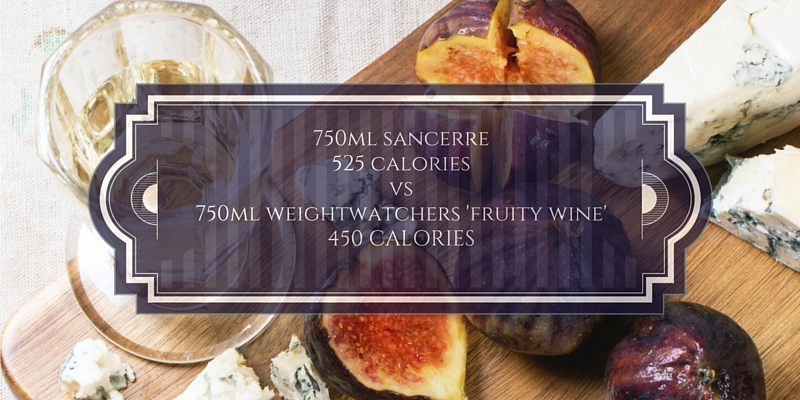The ‘invisible’ calories in wine.
Is your wine intake responsible for being able to pinch more than an inch?
As we enter the festive season, much wine will be consumed; at parties, over dinners and by the fire at the end of a long day.
It’s also the time when many of us want to lose a little bit of weight to look and feel our best for the onslaught of parties and get-togethers with friends and family; and while our first thought is to blame the profiteroles we had after dinner and the large cheeseboard we tucked into for the tightness of the dress we bought in our usual size or the bulge that’s appearing over our waistband, it’s much easier to consign that bottle of Cabernet Franc to oblivion.
For anyone of a “certain age” who doesn’t appear to overeat, or who has a relatively healthy diet, the pounds creeping up can be annoying and a bit of a mystery – but ask them how much they drink. If they’re being honest, they might admit to consuming a half to full bottle of wine a couple of times a week, and at between 100-300 calories per glass, it’s no wonder their girth is expanding more rapidly than they’d like.
It’s a sobering thought to realise a bottle of red wine with 14% alcohol content could almost be the calorie equivalent of 3 McDonalds hamburgers. While most of us would balk at those who eat up to a dozen burgers a week, three or four bottles of wine consumed after work, with dinner or out socialising while we comment on the unique, strong character and aroma of red berries and cinnamon seems altogether more civilised and sophisticated. However, the result on our bodies is the same and could mean as much as a two stone weight gain in as little as a year.
Alcohol is high in calories with 7 calories per gram (carbs have 4 calories per gram), meaning wines with a higher alcohol content such as a Zinfandel at 17% come in around 650 calories per bottle – or approximately a third of the 2000 calories the NHS recommends a woman consumes daily to maintain her healthy weight. Simply put, it only takes a person to consume 500 extra calories per day for a week to put on a pound or two of fat, and in wine fan terms that’s only 3 decent sized glasses of a fruity Beaujolais.
What are the lower calorie options?
The trend for lower calorie wines in recent years has seen a surge in dedicated “skinny” brands, with a somewhat female-centric target audience and rather unsophisticated branding for the most part. For some, it’s a ‘no-brainer’ to pick up a bottle of “Skinnygirl” (launched in 2009 by US reality TV star Bethenny Frankel after her “Skinny Girl Margarita” pre-mixed cocktails flew off the shelves) as a way of keeping the calories in check. A 148ml glass is 100 calories, so there’s no complicated calculations required before purchase, but it’s promoting itself firmly at the ladies and many intelligent women don’t appreciate this kind of marketing (akin to Bic’s pink ballpoint pen). It seems to have been the catalyst to other companies vying for a slice of the low-calorie pie, but disappointingly, the marketing companies behind many of these wines see women as nothing more than high-heel buying, handbag touting shopaholics who don’t really care what the wine is as long as they’ll weigh less as the end of the week.
After almost a decade of researching and three years of testing, New Zealand’s Brancott Estate managed to launch Flight Song last year. Harvesting the grapes earlier in the season when the sugar levels are naturally lower, the 9% abv Sauvignon Blanc comes in at 88 calories for a 148ml glass. The marketing is nice – not specifically aimed at figure-conscious women and the label makes a reference to it being ‘naturally 20% lighter in calories’ without direct mention of dieting. Both sexes should feel comfortable buying this which gives it bonus points and it might be a good option for hot days where its lightness will be appreciated more than in winter. Similarly, launched earlier this year, with the summer picnic market in mind, New Zealand’s Villa Maria’s trio of 9% abv wines have understated branding and wouldn’t look out of place in your shopping basket.
Lower Calories in Wine = Less Flavour?
We all know low-fat and low-calorie foods tend to mean a compromise. Ever tried a low-fat cheese? If not, don’t bother. It’s a hurdle the wine industry has to overcome if they want the low-cal marketed wines to be purchased by anyone other than fad-dieters. However, many people do like to take advantage of a lighter alcohol option, especially during daytime or at lunch meetings when it’s considered impolite to nap afterwards; but taste is still the biggest concern. The ultimate goal would be to make a 2% wine with 14% flavour. You’re not going to find a low-calorie wine that replicates an Italian Amarone, so trade-offs definitely have to be made – but most likely this isn’t a wine you’d be drinking on a daily basis anyway.
Are low calorie wines here to stay?
In August 2013, Australian Vintage’s chief winemaker, Thomas Jung told CNBC there is definitely demand in the UK, and also mentioned both Scandinavia and Canada as countries with thriving markets for both low and zero alcohol wines as more health-conscious consumers aim for a healthier lifestyle without losing any of the social enjoyment.
The “big four” British supermarkets, Morrisons, Sainsbury’s, Tesco and Asda all signed up to the government’s Public Health Responsibility Deal (which aims to remove one billion units of alcohol from the UK market by December this year) and said sales for lower-alcohol wines had been strong. However, Off Licence News said wines at 5.5% abv or less saw a ‘nosedive’ in sales of 12% in the same year, with lower calorie wines having only 0.7% of the still wine market.
A story earlier this year by Harpers highlighted Sainsbury’s work with the University of Adelaide in the research and development of lower alcohol wines. The supermarket, as part of their 20 x 20 campaign to be a more responsible company in many sectors, has set themselves a target to double sales in the next 5 years of lower alcohol, and, therefore, lower calorie wines. They found 85% of consumers had no idea how many calories were in a glass of wine, and more than half omitted their wine consumption completely when calculating their daily calorie intake. In an attempt to make the calorie content more transparent, and allow customers to be more responsible, all of their own-brand wines will be fully labelled with calories by May 2016.
All of the big companies are producing ‘light’ wines; Banrock Station, Blossom Hill, Gallo and First Cape. Whether these will still be on the shelves of your local supermarket in 5 years’ time or whether their range will expand remains to be seen.
Wine and the modern palate
There’s increasing concern about the rising levels of alcohol in our wines, and we’ve recently seen alcohol contents climb up to 17% due, in part, to our palates changing in favour of bigger, fruitier wines and global warming causing riper grapes with higher sugar contents. The critics and wine-drinking-public as a whole are divided. Many are looking for wines with big personalities and deeper flavours, which mean grapes are ripening on the vine even longer than they would in the past, resulting in richer, fuller-bodied wines which contain more alcohol. According to Conetech, around the world, the average alcohol level in wine is 2 degrees higher than it was 20 years ago.
What makes some wines lower in calories than others?
It’s a subject that deserves a whole story of its own, but it can be explained in the simplest terms. As a rough guide, dry whites and light reds from cooler climates namely Germany’s Riesling or France’s Pinot Noir usually have naturally fewer calories and warm regions such as Napa Valley tend to produce riper, higher calorie wines. The ways of bringing the alcohol levels down are not all entirely legal. After fermentation, the must may be diluted with water – illegal but widely practised in some warmer climates, harvest the grapes before they’re fully ripe but risk sacrificing the flavour, or blend with other wines which is bad for quality and won’t work for premium wines. The most common, and preferred ways are the industrial methods of reverse osmosis and the spinning cone which deal with the technicalities of molecules, compounds and vacuums. Critics say these methods remove the terroir and they were in fact banned in the EU until recently, although certain New World wines from Australia and the USA that made use of these methods to remove a percentage of alcohol could be imported into Europe.
Is it worth it to lower wine calories down?
DrinkAware recommends women should try not to exceed 2-3 units a day, and a man 3-4 units. In wine terms, this is 175ml of a 12% volume wine for women and around 250ml for men. For some wines, the lower calorie versions are only 20 calories less per glass, which for many people doesn’t seem like a big enough saving to merit swapping allegiance for. (January 2016 update: guideline limits for men are reduced to 14 units per week, see more on our Forum)
The Party Season and Wines
Don’t let calorie counting curb your celebrations. Champagne, known as the lower calorie option is only 95 calories per 125ml glass. Traditionally demi-sec or doux champagnes had around 50g of added sugar or grape must per litre, but there’s a growing trend for ‘ultra-brut’ champagnes with less than 6g of added sugar and even ‘zero dosage’ where no sugar is added at the end of the fermentation process and the only sweetness is from the grape. Favoured by Kate Moss and the fashion crowd to stay supermodel-thin without being labelled party poopers, these champagnes are only 65 calories per glass and include Laurent Perrier’s Ultra Brut, Pol Roger Pure Brut Nature and Ayala Brut Nature. Be aware that all other sparklers that are not pure Brut Nature will have increased sugar levels and thus a lot of additional (and sometimes undetectable) calories.
The Solution for reducing Wine Calories intake?
There are drinkable lower calorie wines out there, but perhaps there are much more sensible solutions to deal with a slight paunch and a quest for an overall healthier lifestyle; work a little harder for your drink – go for a stroll in early evening and keep your metabolism up, move around more in your everyday tasks, or swap a few biscuits you’d normally have with a cup of tea for a glass of something later.
Try to stick to wines around 13% abv in average, don’t drink too close to bedtime so you get a better night’s sleep and feel smug in the knowledge that red wine is higher in antioxidants than some so-called superfoods.
Most importantly, we should all just consume higher quality wines (but less) instead of more of the ones that are just so-called booze.






